Monday, July 31, 2006
Website is Back Up, and Enough About Me
Sorry I haven't been blogging -- I've recently re-activated my website, and little by little I've been updating it. I've added images of my recent work at the weaving & surface design link. Take a peek if you're interested:
http://www.brenahearn.com/
Thanks to Judy G. for her comments to my last post. It's great to see others interested in the area, and I can't wait to see images of Judy's ribbon/text project.
Speaking of ribbons -- Judy, you can get the ribbon magnet at this URL (it arrives in about a week or so):
http://www.qgiftsonline.com/store/magnet_ribbon_just_pretend_its_all_ok.html
Readers -- I'd like to hear from you about your text/textile experiences. (Enough about me -- let's have this be a dialogue.)
More next time.
B.
Wednesday, July 19, 2006
Hiatus Interruptus & Ribbin'
It's hard to stay away when there are so many interesting stimuli everwhere, so I guess I'm off hiatus for a while.
A few entries ago I had talked a bit about my fascination with American society's continued elevation of ribbons to precious status, even though the ribbons may now be massed-produced, plastic, and no longer labor-intensive and expensive items to produce.
Over the years ribbons have had a symbolic role in the US. In the 1970s Tony Orlando and Dawn sang "Tie a Yellow Ribbon Around the Old Oak Tree," in which they requested that the recipient of the song tie a ribbon if he/she wants the singer to come home. In some wars a yellow ribbon was used as a symbolic gesture to the veterans to come home. (I was young when Tony Orlando & Dawn's song came out -- was this a Vietnam war song?).
In the early 1990s red ribbons were worn to promote AIDS awareness, and in recent years ribbon stickers have appeared on cars in support of soldiers and/or the US invasion of Afghanistan, Iraq, & counting.
A few weeks ago Doug and I were in Pacific Grove, CA (near Monterey), and we came across a car with this sticker on it:
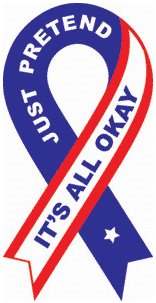
This sticker of course appeals to my love of the subversive. Text is being used with a representation of a precious ribbon to convey a message. The ribbon with its red, white & blue coloring initially appears to be in support of the invasions, but the written message clearly is an anti-war message about people's acceptance of the rhetoric of the government. Just this past weekend, we watched the documentary, "Murderball," which is about paraplegic rugby. At the end of the documentary, the players were showing their sport to wounded veterans from the recent invasions (veterans' legs were missing, etc.). I remember saying to Doug, "Oh my god. They're just kids." These veterans were perhaps 18, 19 or 20 years old. Why is there censorship of images of flag-draped coffins and wounded veterans? Is this censorship by the government or by the press? I think that this censorship gives the message that everything is all OK. But is it really?
Relating back to the text-textile connection -- it's interesting how the ribbon has migrated from a textile to a sticker with text for cars. (Also, I've bought a magnet of the above image for my refrigerator.) It's interesting how the ribbon shape is maintained. Is this ribbon shape that powerful? Is it that precious?
Maybe this blog should be called the text-sticker connection.
B.
Sunday, July 09, 2006
Hiatus
Recently I've been feeling like weaving instead of writing, so I'm going to take a break from blogging for a while. I'll post the photos of my work taken by Charr when I get them from her in a few weeks. Thanks for tuning in.
B.
Sunday, June 25, 2006
A Man in a Uniform
Here's the latest on the grad school front -- I've been in touch with Prof. Susan Kaiser of the UC Davis Division of Textiles and Dept. of Women and Gender Studies, and she has agreed to chat with me about my grad school interests and an appropriate path for me to take. Among the topics of interest for Prof. Kaiser is the social meaning of clothing. I've just begun reading her book, The Social Psychology of Clothing: Symbolic Appearances in Context, and my mind is going in all sorts of directions about the possibilities. It's exciting to have a passion & to finally be exploring it.
On a related matter, yesterday Doug and I went shopping for more summer shirts. As I mentioned last week, I had hardly any summer shirts since I had lived in the San Francisco Bay Area for several years. I tend to gravitate towards plaid/tartan cotton shirts for the summer, and Doug commented that I was getting a uniform for work. I've been thinking about this comment, and I think that my position as a secretary has influenced my selection of clothing. I think that it's important for me to project an image of being reliable and consistent in my work life, and I think that my selection of not-too-outlandish clothing reflects this image I'm trying to portray. Perhaps I'm totally off in my perception of my reliable and consistent image -- I've skipped ahead in Prof. Kaiser's book, and there's one section in which she writes about the Tseelson study[1] in which the wearer's perceptions of the message conveyed by the clothing were compared with the message received by the viewers. I'd be interested in seeing if my co-workers view my clothing as really projecting a reliable and consistent image.
On another level, I also like dressing conservatively (or what I think is conservatively) and then shocking viewers of my more racy artwork (e.g., the cock ring, the spaghetti jockstrap, and the cut-up bible piece) with the disconnect between my appearance and the outlandishness of these pieces.
Any thoughts, readers?
On a final note, my purchase of the additional summer shirts may be a moot point, as there appears to be a cooling trend -- on Friday it was 103F, and yesterday it was only 100F.
-----
[1]Tseelon, E. 1989. Communicating via clothes. Ph.D. dissertation, Oxford University.
Sunday, June 18, 2006
Socks Appeal
Pennita responded to my previous post about grad schools with the possibility of California College of Arts in Oaktown, CA. I had thought about that school (and CCA does have Deborah Valoma, who does textile antropology). I'll have to do some thinking.
Yesterday I actually went shopping for summer clothes. I had lived in the San Francisco Bay Area for so many summers that I hardly had any summer clothes, and it gets hot during the summer in Sacramento, CA, where I now live.
At the clothing store, I also decided to buy some new dress socks for work and some new white socks, which I wear during my play time. My old white play socks are still intact, but they're kind of gray. After we got home, Doug did a load of whites & washed the old white socks, which I plan to wear one more time before throwing out. I was sorting out the socks and was amazed at the good memories that the socks evoked. Here's a picture of three of the socks:
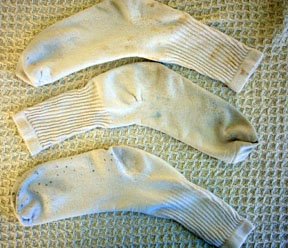
The top sock has the the red dirt stains from when Doug and I hiked the Na Pali coast on Kauai, HI in 2004. The middle sock has a blue spot from a dyeing day, and the bottom sock has black spots on the bottom from a workshop with Jacquetta Nisbitt at the 2004 Conference of Northern California Handweavers. I was shocked by the emotional attachment I had towards these graying socks. These gray play socks evoked the memories of happy times, and I thought of a different take on Yoshiko Wada's term (and name of her book), Memory on Cloth. Wada writes about cloth taking on the memory of shibori processes, but in yesterday's sock case, my own memories were displayed on the cloth, which reminded me of the power of textiles to elicit a range of emotions from me.
Speaking of textiles eliciting memories & emotions, Mary Chapin Carpenter wrote a song in the 1980s called This Shirt, in which she describes the history of a particular shirt and her love of the shirt. At the end she sings, "This shirt is a grand old relic, With a grand old history...So old I should replace it, But I'm not about to try." (Ths lyrics are at the linked song title above.)
Speaking of memories, that song, This Shirt, was introduced to me by Jack Horn, someone I dated in the late 1980s (and who is MIA). So, that song brings up all sorts of memories. Another person I dated, Jeff Darcy, raised the related question asking if memories really are forgotten or do we just need the appropriate stimulus for the memories to come to the surface? Interestingly enough, music also has the power to evoke memories for me. My hearing a song brings me right back to the era when the song was popular.
I'd love to hear some of your thoughts about the power of textiles & music to evoke memories & emotions.
About what I'm working on -- I'm finished 1/4 of the 4th triple weave strip, so that's coming along slowly. I think I finished the bible piece this morning. Over this past week I realized that if I want to enter the bible piece in quilting shows, I probably need a backing layer. So, I decided to attach a used distowel to the back & call it a day. Here are pictures of the front & back:
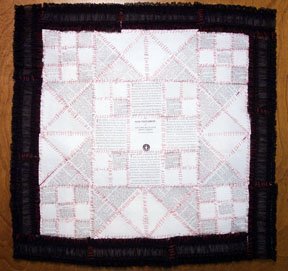

I'll post the good images after Charr takes them later this month.
B.
Sunday, June 11, 2006
Misc.
Wow. I've been such a deadbeat blogger. I've been feeling creative (which I haven't felt in months), so I've decided to go with it & create. I put a border on that bible piece, which I mentioned in my bible piece entry a while back. You may remember that I had wanted to put black garters as a border, but I was having trouble getting garters shipped at a reasonable rate. So, I instead decided to make my own garters to save money. With the cost of materials, the amount of money I spent was the same as if I had bought those other black garters & had them shipped. And I also had to make these new garters. I think I learned my lesson on that one. Here's a bad photo of an edge:
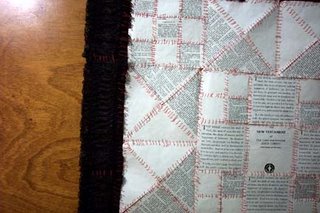
Unfortunately, in this photo you can't see that I had sewn the garters to each other & to the bible pages with that same red thread. Fortunately, later this month I'm going to have the fabuzoid photographer, Charr Crail, take images of this piece & some of my more recent pieces. I'll post them probably in July.
When I was working on the piece, Doug commented that it looked Victorian and that it looked like an old fashioned sampler. That notion of a sampler inspired me to put the piece into a frame & call it a day.
I finally finished reading Caramelo by Sandra Cisneros. I don't know if you remember my remarking that this book is full of textile metaphors. One rich metaphor towards the end of the book in Chapter 80 is "The universe is a cloth, and all humanity interwoven. Each and every person connected to me, and me connected to them, like the strands of a rebozo. Pull one string and the whole thing comes undone. Each person who comes into my life affecting the pattern, and me affecting theirs."
Last night Doug and I were watching the new Pride & Prejudice movie. In one scene the characters are shopping for ribbons. In another scene, while the family is scurrying to get ready for a distinguished visitor, the mother calls to the daughters to get out the ribbons. It was interesting to see a scene about a time when ribbons were a high-status item.
Last week Doug told me to apply to my dream school for grad work. I've decided that I'd like a school that would allow me to not only do design, but would allow me to explore textile anthropology & the text-textile connection. I'm thinking perhaps UC Davis or Phila U or maybe returning to San Francisco State U. Readers -- do you have any suggestions?
I hope you read Sista Sledge's comment to my last blog entry, in which she challenges the relegation of craft to second-class status. You go sista! (Sista Sledge is my nickname for my sister, Mary Kay.)
B.
Saturday, May 27, 2006
Love for Sale
Sorry for the lapse in posting -- we went to Vancouver for a few days. When I returned, there was an e-mail from Kathy Murphy (AKA "Supa K," the Loom & Shuttle Guild Newletter Editrix) that the June 2006 guild meeting will be a celebration of the contributions of longtime member, Mary Schwartz, who is 100 and has been a member of Loom & Shuttle since 1949. Mary is always so kind and willing to share her latest creative endeavors with the guild. I think it's great that she's being honored. Happy birthday Mary, & thanks for being so welcoming when I joined Loom & Shuttle and for continuing to welcome new members!
While Doug and I were in Vancouver, we went to Granville Island, which is a successful experiment in urban redevlopment that appears to have a little bit of everything, e.g., some artisan worshops, a public market selling food that locals buy, the Emily Carr Institute of Art & Design, and even a cement factory. Of course I was interested in going into the fiber studios. Among the fiber studios was the Textile Context Studio at which there was an interesting piece that was a globe that opened up and had mutiliated world currencies inside. To me this piece was very loaded, with references to money, power, etc.
We also went to Maiwa Handprints, which supports artisans around the globe. We got a few pillowtops embroidered by members of the Kutch Mahila Vikas Sangathan coop in western India. It's interesting--I ordinarily hate shopping because I feel as though big money is telling consumers that they need to buy in order to stay au courant; however, I can shop for textiles & books for hours. I enjoyed this store without my itching to get out after 5 minutes.
I also was interested in going into the Silk Weaving Studio, as I had never seen a weaving business. I was curious to see this business because I weave for the pleasure & mental challenge, rather than for income. There were four looms in the studio, as well as yarns & finished goods for sale. There were a few garments and a number of scarves for sale. When I left the studio, I couldn't help but wonder if scarves are the only viable weaving option for a North American weaver who wants to earn a steady income by weaving. I'm theorizing this because textiles are so undervalued in North America; however, I think that a person might be willing to spend a few hundred dollars for a special piece, and a scarf can be purchased for a few hundred dollars. So, I'm proposing that scarves are the most efficient thing to weave for those who wish to at least recoup the cost of materials. I've only sold one commissioned piece in my history and haven't offered my other pieces for sale because I weave for my own exploration and enjoyment. Also, I don't think that the majority of people in North America would be willing to pay what a piece actually is worth (e.g., when I had to list the insurance value of one of my strip weavings that was going to be in a show, I wrote several thousand dollars as the value). I do give away pieces, though -- I think that money taints the exchange in terms of expectations, resentments, etc. Also, is it possible to put a monetary value on something one loves to do? Does the placement of the monetary value make the activity become something less-loved? Any thoughts on this, readers?
Finally, when I was on the way to Vancouver, I finished sewing together the three triple weave strips. After doing this, I realized that I need about 10 more strips. So, I'm back to the loom. (Currently, this is about a $6K piece, if one's putting a monetary value on the piece.) Anyway, here are photos of the full piece to date & a detail:
I dyed the 2nd & 3rd strips in a different dyebath than the first one using the Bren formula of non-measurement, so I'm lucky that the color matches pretty well.
As a final comment, I hope that you're checking out the comments on this blog, and please feel free to comment. Among the response to my more recent posts is one by Jan Moore, in which she candidly writes about how her textiles reflect her personal experiences. Also, Pennita Peters raises that art/craft question. It's a good point she raises -- do I consider my one-offs to be art, while the other numbered pieces are craft? I've always been more interested in process rather than product, and I think that I number my strip weavings to show the history and progression in my process. For example, the triple weave strip weaving that I'm working on is currently called: "Strip Weaving 4: Shibori Strip Weaving 3: Japanese, Kente, Resist Triple Weave Strip Weaving" (For lack of better terms & because of the textiles evoked for me, I used the term "Japanese" to refer to the section that is 1/3 white & 2/3 blue, while "Kente" refers to the striped sections. The jury is still out on if I'm exoticizing these cultures' textiles by this nomenclature. Thoughts on this are welcome too.)
Until next time,
Bren
Saturday, May 13, 2006
Strip Strap Strup
The Conference of Northern California Handweavers was last weekend in Modesto, and at the conference I chatted with Sara Lamb and Mollie Freeman about how I've been feeling disconnected from the Sacramento weaving community since I moved to Sacramento because the guild here meets during the week while I'm at work. When I lived in the Bay Area, I joined the Loom & Shuttle Guild, which meets on Saturdays, and I've developed these wonderful friendships and have gotten a lot from the members who were more than willing to mentor & guide me along when I was weaving in "butt-ugly colors" (quote is from Penny Peters). I'm still a member of Loom & Shuttle and think that perhaps I should make more of an effort to get down to their meetings. Sara Lamb has interesting ongoing statements on her blog about the future of weaving. If you check out her blog, make sure you check out the comments by her readers.
What've I been doing? On Thursday I finally finished the third & final triple weave strip. Two of the layers are poly sewing thread, and the third layer is cotton. Last night I fed the 2nd & 3rd strips (the undyed strips) through the pleating machine, and today I dyed them. Some people ask how a pleating machine works. A pleating machine has a bunch of rollers with needles between the rollers. The needles are placed pointing into the machine, and the tips of the needles are curved, which keeps the needles in place among the rollers. Once the needles are in place in the machine, the eyes are threaded. Fabric is fed through the pleater (which is kind of like a pasta machine), onto the needles (since the pointy ends of the needles are in the inside of the machine), and then onto the thread. Once all of the fabric is fed throught the machine and onto the thread, the fabric is compressed & then dyed. Here are pictures of the curved needle & the threaded machine before the fabric is fed through it:


Here is the beginning of the fabric being fed through the machine, onto the needles, and then onto the pullup thread:

Here is all of the fabric fed through the machine:
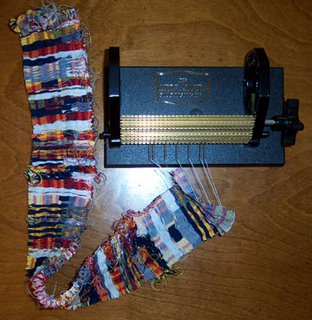
Here is a mockup (and a detail) of the three strips post dyeing and pre-stitching (The blue speckled areas are the cotton areas that were on the outside of the pleated bundle and thus were exposed to the dye.):

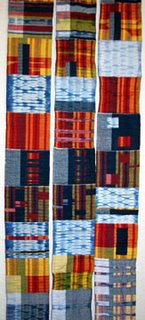
I'll use red thread to sew the strips together. The final size will be ~78" X 10". I have more warp, but I'm so over this project & I'm ready to move on. I also think this piece is a bit too busy. I'm very grateful to Peggy Osterkamp who has taught me multiple layer weaving. Peggy is an awesome teacher.
Sunday, April 30, 2006
Deadbeat Blogger & Other Things I've Been Called
Sorry to have been such a deadbeat blogger. Last weekend Doug and I went to San Francisco State University to the MFA show and then to Oakland, CA to a party given by our friends Quang Dang & Donald Williams. I met Quang 13 years ago -- he was an acquaintance of a person I shouldn't've been dating. My friendship with Quang has lasted a lot longer than that love affair. I hadn't seen Quang for over 10 years, and when we got together it was very easy -- we just fell back into the rhythm of our friendship.
Quang & Donald had the party to thank their friends for sponsoring them as they participate in the 2006 AIDS Lifecycle (Click here if you'd like to contribute to Quang & Donald's ride & also to take a peek at their training blog.) I'm very grateful that Quang & Donald are participating in this ride, not only because they're raising money for AIDS research, but these events remind the public that the worldwide phenomenon of AIDS hasn't gone away just because some people in the US don't have the same visible manifestations as the AIDS patients in the 1980s. (I vividly remember in the 1980s seeing people my age -- at the time in my 20s -- walking with canes and dying; I cannot explain the lasting impression these images have made on my psyche & the occasional survivor's guilt that I feel.)
This experience has reminded me of the AIDS quilt, a portion of which I saw in the late 1980s in Philadelphia with my friend, Melva Hightower. I remember thinking how subversive it was to use a medium associated with domesticity and comfort, a quilt, and to associate it with such a controversial issue. I later learned that quilts have a whole history of being associated with the subversive (e.g., quilts being used to guide slaves to freedom). The AIDS quilt is incredibly moving, as it humanizes AIDS. (As a side note, I haven't seen Melva for years, but she is a textile artist, and I've learned that she's heavily involved in the wonderful ArtQuilts at the Sedgwick show. Click here for more info on Melva.)
 This thought about the AIDS Quilt reminded me of an abandoned project from last year. A few years ago the Loom & Shuttle Guild in San Francisco had a nametag competition, as a way to get members to create nametags to wear. I had intended to create a card-woven nametag similar in style to those nametags with the text, "Hello. My name is..." The project turned out to be too involved for me to finish in time (there were ~200 cards), so I decided instead to do some nametags with names I had been called in my past. While I was weaving the first nametag with the words, "Hello. My name is Faggot," the cord holding the warp stick to the loom broke, and the cards went all over the place; I then abandoned the project. An image of the unfinished project is above. Note how only the word "HELL" is woven at the top, which is an appropriate word to describe the whole project.
This thought about the AIDS Quilt reminded me of an abandoned project from last year. A few years ago the Loom & Shuttle Guild in San Francisco had a nametag competition, as a way to get members to create nametags to wear. I had intended to create a card-woven nametag similar in style to those nametags with the text, "Hello. My name is..." The project turned out to be too involved for me to finish in time (there were ~200 cards), so I decided instead to do some nametags with names I had been called in my past. While I was weaving the first nametag with the words, "Hello. My name is Faggot," the cord holding the warp stick to the loom broke, and the cards went all over the place; I then abandoned the project. An image of the unfinished project is above. Note how only the word "HELL" is woven at the top, which is an appropriate word to describe the whole project.Next weekend is the Conference of Northern California Handweavers in Modesto, so I'll be blogging again in a few weeks.
B.
Sunday, April 16, 2006
Something Old, Something New & What's in a Name?
Thanks for the comments to the last post. Sara & Judy left interesting comments about their experiences with labels & labeling. Sista Sledge shared an experience that forced her to take her textiles out of storage. (Sista Sledge actually is my sister, Mary Kay, who creates wonderful costumes for theater productions. FYI My mother is a quilter; so there is a tradition of textiles in my family.)
I'm going to deviate a bit from the text-textile connection in today's posting. I've been lucky enough to have been invited by the fabuzoid wedge weaver, Deborah Corsini, to appear in a master/apprentice show as her apprentice. Deborah is also influenced by international textiles, and she has been very influential in the dyeing and quilt fabric design communities. Her work is in many collections, including that of US embassies overseas. One of her wedge weaves actually was the image used in the publicity for the event. The show is sponsored by the Baulines Craft Guild, and is called Inspired by Marin -- the Spirit of the Baulines Craft Guild. Here's that image of Deborah's that was used for the publicity:

The show's opening was Thursday, April 13, 2006, and I'm going to show a few pieces that I have in the event. The first one is a new piece called Shibori Strip Weaving #2, which is a strip weaving of plain weave white dumpster rayon strips shibori dyed in indigo. (The rayon is called the dumpster rayon because my friend Amanda Snedaker retrieved the rayon from the dumpster when the Berkeley yarn store, Straw into Gold, closed a few years back. The rayon was left over after the final sale ended, but the employees couldn't give her the rayon. The employees put the rayon into the dumpster, and then Amanda had to retrieve the rayon from the dumpster. Maybe the employees weren't allowed to give away merchandise?) This piece is 116"H x 49"W (including fringe), when it's not wrapped on a dress form. Unfortunately, I forgot to bring my camera to the opening, but Asoke Thapa graciously agreed to take images of my two new pieces & e-mail them. Thanks to Asoke. Here are images of the full piece and a detail of the train:
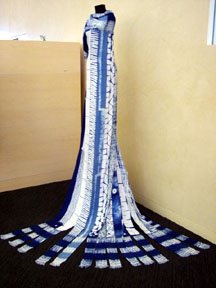
Another new piece I had in the exhibit was Shadow Weave Strip Weaving, woven from l0/2 tencel. Here are two more images by Asoke:

Also in the show was that triple-weave strip that I mentioned a few posts ago, as well as three older pieces: Oh Kuso, which I mentioned in my first post, as well as Spaghetti Strap #2 and All American Cock Ring.
Spaghetti Strap #2 was created for the Conference of Northern California Handweavers 2004 exhibit gallery entitled The Body Adorned. It is a sleazy basket weave of spaghetti with a card-woven label of double-faced tablet-woven lettering saying "Noodle & Co." (Thanks to Linda Hendrickson who taught me double-faced tablet-woven lettering. Check out her site, especially the table-woven pangrams in her gallery.) Here's an image of the spaghetti strap taken by Sarah Wagner:

The final piece is All American Cock Ring, which is a double-faced tablet woven cock ring, with the words, "Does size really matter?" on it. A cock ring is a device that a man wraps around certain parts of his body to keep one part of his body engorged with blood. I also included images of a house and car, which are two other American male fertility symbols in which size seems to matter. I created this piece because I am mystified why there is a preoccupation with size in American culture and why many Americans cannot be happy with un-supersized things. Also, as a member of the gay community, I am mystified by gay culture’s glorification of giant phalluses. It seems to me that this preoccupation with bigger things is a result of people not being happy with what they have and not looking within for happiness. Of course, the commodity culture of the media plays a huge role in people’s unhappiness because people are told by the media that they are not “good enough” if they do not have the latest, greatest, and biggest thing. Also, there is peer pressure to acquire bigger and better things. Which force drives which – do the media drive people to be unhappy and consume or does peer pressure drive the media or is it circular? On another level, the placement of the handwoven cock ring on the industrial mill bobbin can be viewed as representative of the male/female realms and the tension between the two. Historically in America, females have been relegated to the handicrafts realm, but when textiles became industrialized (and money could be made), men managed the mills. My placement of this handwoven (i.e., female realm) piece on this industrial (i.e., male realm) bobbin actually was an accidental a tongue-in-cheek gesture that ended up having symbolic meaning. Another take on this is the idea that the lowly-status woman is supporting her flaccid man. To tell you the truth, I didn't have all of this in mind when I put the ring on the bobbin -- I just thought it looked good. Only after the fact did I realize the significance (if any). Here are images taken by Sarah Wagner of the full piece & detail:


Finally, to adress the question: "What's in a name?" At the opening of the event, my friend & mentor, Marlene Golden, told me that I needed better names for my strip weavings. I thought about it, and I realize that I don't have exotic names for my strip weavings because I'm fascinated by process & documentation of my process. Naming a piece Shibori Strip Weaving #2 may be boring, but it helps me keep track of the placement of that piece in my creative process, i.e., that's the second strip weaving in that style. I notice, however, that on the one-offs, or pieces that won't have a follow-up (e.g., the All-American Cock Ring), I do use more creative names. Lots to think about.
Sunday, April 09, 2006
Yes, I owned Jordasche jeans
I'm getting interesting comments on my blog. I hope you'll take some time to read them and learn about other fiber people's journeys. In response to my last post, Cathy & Stephanie have told stories of textiles that have meaning for them, and in response to my earlier posts, several text-textile people (e.g., Linda, Laura, Ozweaver, Neki desu, et al.) have explained how they have come to enjoy the text-textile connection.
I originally was going to write about ribbons because yesterday I worked at a conference at which the speakers & volunteers had ribbons attached to their nametags with the words "Speaker" & "Volunteer" printed on the ribbons. I was thinking about how ribbons have come to be mass-produced items, and that there still is a certain status attached to ribbons, no matter how un-hand-made & nonprecious the ribbons are.
What made me change my mind is an e-mail I received this morning. A friend of mine told me that during her recent trip to Japan, she was dismayed because her co-travellers spent a lot of time focussing on the authenticity or lack thereof of designer goods that they saw. Fortunately, my friend was able to bring some of her weaving with her and to have a cross-cultural dialogue with weavers she met. She also was able to see living weaving and dyeing museums & participate in other fiber activities, so she was able to occupy herself while her friends were occupying themselves.
This situation reminded me of two similar situations I experienced in my young adulthood. The first time was in 1982 when somone on my college dorm floor announced to everyone that my Ralph Lauren Polo shirt was a forgery. I knew that the shirt was a fake; I had bought it at a flea market. I felt exposed, though. The second incident occurred during a trip to Amsterdam in 1986, during which my friend seemed intent on announcing in front of vendors that their Delft ceramicwares were forgeries. I know that I'm not supposed to be embarrassed by other people's behavior, but I felt embarrassed to be an American and felt guilty by association.
So, what is it about American culture that undervalues the effort of hand-produced textiles, yet glorifies mass-produced textiles with designer names on them? It seems that people should be glorifying the hand-made items in homage to the time, effort, and love that went into making them. What is it about the culture that makes people point out if a designer good is a fake? Is it a power/social class thing, i.e., a way for people who have the means to put the people who buy the fakes in their place? Does the fashion industry create impossible expectations for people to be au courant, thus fueling the industry for lower-priced fakes for lower-income consumers?
Why do people insist on paying lots of money for these designer goods with the names of the designers readily visible? I must admit that I was guilty of this in my youth with my Polo shirts and Jordasche jeans; most recently I purchased a plaid Polo shirt on discount from Macy's. This most recent purchase was in homage to my fascination with Polo of my youth and also because the colors; however, was I still in the consumerism mode of my youth?
On a related topic, when Doug and I moved last year, I actually found my Penn sweatshirt from my college days. When I was 22, my Penn sweatshirt was more than just a sweatshirt; it was a symbol announcing to the world that I have arrived as an Ivy League student. (My bragging was restrained, though -- I thought it was tacky to wear a Wharton sweatshirt.) Whenever I wore the shirt, I felt better and more confident. I now realize that during those days I was getting my validation from external sources, rather than from within. The sweatshirt was so worn during those days that I actually tore off the worn hood and called the shirt my Flashdance sweatshirt because of its resemblance to Jennifer Beals' sweatshirt from Flashdance. (I probably even saw Flashdance in the theater while wearing this sweatshirt.) When I found this sweatshirt last year, I was taking Linda MacDonald's surface design course at San Francisco State University, and I decided to make the sweatshirt into a strait jacket as a reminder that I felt tortured during my undergraduate days not only as a person seeking validation through external sources, but also as a closeted gay man. On the back of the strait jacket I decided to applique images of my secret college lovers and me and to embroider lines showing how my lovers were connected not only through me, but sometimes through each other. There's a legend on the back explaining the connections, e.g., gold = sex partners, dark green = love triangle, etc. It was interesting contacting these ex-lovers to get permission to use their images. One person, who was in Navy ROTC during college and is now married with a child, refused permission. Here are images of the front & back:
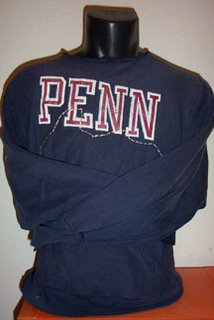
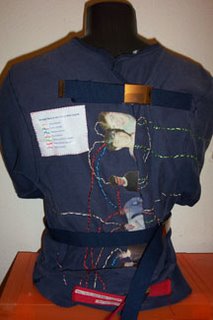
Here's a detail of the back (The legend's in the white box):
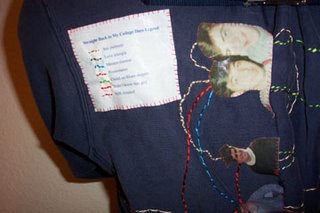
Would you write comments & tell me your thoughts about labels, status, or whatever you feel like?
Thanks, B.
Saturday, April 01, 2006
Bible Piece and Getting the Journey Out of the Closet
Here is a picture of the bible piece that I tried to upload during my last entry. As mentioned in the last entry, I created this for Linda MacDonald's surface design class by cutting out bible passages dealing with the subjugation of women and sewing the pieces together. The block is a traditional one called "Bridal Path." I created this one block, and then thought I should make more. So, I created 3 more. Four blocks together didn't look as awesome as I thought it would. It looked like just a grayish thing. I was talking about this situation with Candace Crockett last semester, and she said that the single block has an intimacy that makes people want to approach it & read it. So, I've decided to go with just one block and to back the piece with garters, since garters have a certain resonance at weddings. I also decided to use garters to frame it. I'm in the process of getting these garters. One vendor wanted over $30 to ship 30 garters. I can't imagine 30 garters requiring $30 of postage unless they were coming from another continent. So, the garter acquisition process is ongoing. I'd gladly hear of any suggestions where I can get black garters on the cheap.

Here's a close-up. I realize that this isn't such a good picture because one can't read the text.
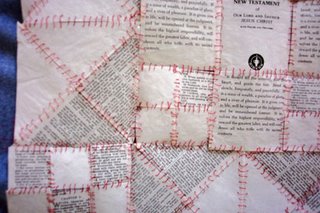
 On to getting the journey out of the closet: Earlier today Doug and I purchased this fabuzoid Angela Adams rug. Angela Adams is an innovative designer whose creations have a mid century modern twist. To the left is a picture from her website of the rug we bought. In the past Doug and I have lived in homes with a lot of character; however, we currently live in a sterile condo built in 1980. We realize that we have to dress up the place. Somehow, our having bought this rug was a spark for me to get all of those exciting textiles out of the closet. Over the years I've acquired textiles, but haven't displayed them because I didn't want them to get damaged or dirty, etc. For some reason, today I thought, "I need to bring these textiles out of the closet & enjoy them because who knows how much time I have left?" These textiles that I pulled out today are a record of my journey & friendships, so why not have these reminders visible? Here are a few pictures:
On to getting the journey out of the closet: Earlier today Doug and I purchased this fabuzoid Angela Adams rug. Angela Adams is an innovative designer whose creations have a mid century modern twist. To the left is a picture from her website of the rug we bought. In the past Doug and I have lived in homes with a lot of character; however, we currently live in a sterile condo built in 1980. We realize that we have to dress up the place. Somehow, our having bought this rug was a spark for me to get all of those exciting textiles out of the closet. Over the years I've acquired textiles, but haven't displayed them because I didn't want them to get damaged or dirty, etc. For some reason, today I thought, "I need to bring these textiles out of the closet & enjoy them because who knows how much time I have left?" These textiles that I pulled out today are a record of my journey & friendships, so why not have these reminders visible? Here are a few pictures: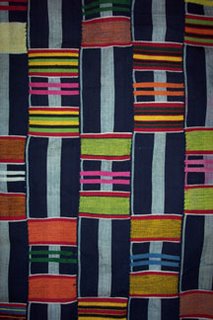 The first piece that I pulled out was this Ewe strip weaving. When I turned 40 in 2004, I wanted to treat myself to a piece of kente cloth. At the 2004 Conference of Northern California Handweavers, there was a vendor selling kente cloth. I had planned to buy the geometric Asante cloth, the image of which has been appropriated to represent all of African textiles, but this piece of Ewe cloth really struck me, so I bought it. (More about appropriation/exoticization of other culture's textile traditions will come up in a future blog entry.) A detail of the cloth is at the left.
The first piece that I pulled out was this Ewe strip weaving. When I turned 40 in 2004, I wanted to treat myself to a piece of kente cloth. At the 2004 Conference of Northern California Handweavers, there was a vendor selling kente cloth. I had planned to buy the geometric Asante cloth, the image of which has been appropriated to represent all of African textiles, but this piece of Ewe cloth really struck me, so I bought it. (More about appropriation/exoticization of other culture's textile traditions will come up in a future blog entry.) A detail of the cloth is at the left. I then came across a printed textile that my friend Sandy Ellison brought back from Japan for me. I had been teaching her some shibori techniques, and she found this printed fabric of a shibori pattern. This piece reminds me of my good friend Sandy & the fun lunch breaks we've had manipulating cloth & sharing creative ideas. I've put this piece on the back of my loom chair so I could be reminded of that creative interchange with Sandy every time I sit down to weave.
I then came across a printed textile that my friend Sandy Ellison brought back from Japan for me. I had been teaching her some shibori techniques, and she found this printed fabric of a shibori pattern. This piece reminds me of my good friend Sandy & the fun lunch breaks we've had manipulating cloth & sharing creative ideas. I've put this piece on the back of my loom chair so I could be reminded of that creative interchange with Sandy every time I sit down to weave. I also found this wonderful piece that my friend Lary Abramson gave me a number of years ago. It appears to be of a Mezoamerican deity. Lary has been a wonderful friend who helped me through some tough times in my 30s when I was dating someone I shouldn't've been dating. (Haven't we all been there?) I have to find a special place for this piece.
I also found this wonderful piece that my friend Lary Abramson gave me a number of years ago. It appears to be of a Mezoamerican deity. Lary has been a wonderful friend who helped me through some tough times in my 30s when I was dating someone I shouldn't've been dating. (Haven't we all been there?) I have to find a special place for this piece.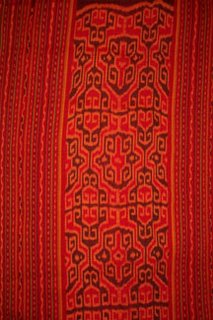 This ikat piece is from Trevor, an ex of our good friend Clark Wilson. I rarely see Trevor any more, but I was touched when he said he had me in mind when he selected this piece for me during his trip to Indonesia.
This ikat piece is from Trevor, an ex of our good friend Clark Wilson. I rarely see Trevor any more, but I was touched when he said he had me in mind when he selected this piece for me during his trip to Indonesia. I also came across this piece that I received when I was living in Japan in 1995-1996. A friend of one of my students created this piece. They tried to explain the process to me, but at the time I had no knowledge of the creation of textiles. Looking at it today, I imagine the piece probably is katazome (stenciling). John Marshall is an American katazome master. There's great stuff on his site.
I also came across this piece that I received when I was living in Japan in 1995-1996. A friend of one of my students created this piece. They tried to explain the process to me, but at the time I had no knowledge of the creation of textiles. Looking at it today, I imagine the piece probably is katazome (stenciling). John Marshall is an American katazome master. There's great stuff on his site.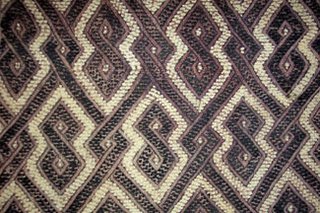 The final piece has always been out of the closet, but I dusted it while I was in my celebration mode. I bought this cut raffia piece at a flea market in Santa Fe the weekend I met Doug there. (We both were vacationing there at the same time.) So, I initially bought this piece because I loved it, but it also has come to remind me of that wonderful weekend.
The final piece has always been out of the closet, but I dusted it while I was in my celebration mode. I bought this cut raffia piece at a flea market in Santa Fe the weekend I met Doug there. (We both were vacationing there at the same time.) So, I initially bought this piece because I loved it, but it also has come to remind me of that wonderful weekend.My question for you readers is what do your textiles mean to you? What are their connections with your journey?
Sunday, March 26, 2006
Reading Textiles
I'm thrilled at the comments that people have been leaving on my blog. It's great connecting with people all over the world about the text-textile connection. We fiber people are lucky because we have a language that connects us to other fiber people. How many times have you met another fiber person and felt an instant connection due to this common language?
Today I feel like writing about the reading of textiles. This topic just sort of materialized a few days ago when I began re-reading Sandra Cisneros' Caramelo. I had been interested in re-reading the book because I wanted to revisit the grandmother's working with the fringe of rebozos, which are Mexican multi-purpose shawls. (This definition is an oversimplification.)
As I began reading, I was immediately reminded of the lushness of Cisneros' text, and I noticed a few textile metaphors. For example, when the family is driving to Mexico, the dotted line on the road is compared to stitches produced by a sewing machine.
I'm not that far into the text yet, but one thing that has struck me is the grandmother's comments about the lower quality of current rebozos. This analysis by the grandmother got me thinking about how we, as textile people, actually have this knowledge to read textiles that most people in industrialized societies don't have. For example, a few years ago my boyfriend, Doug, bought a pile rug. A short while later he was lamenting the fact that the rug was flat so soon. I pointed out that it probably was because the pile wasn't dense enough, so the pile just fell over.
Have you found that sometimes you're treated like an exotic creature in society because you work with textiles and/or know how to read them?
A few years ago I took a surface design course with Ana Lisa Hedstrom, who focuses on shibori (in particular, arashi). Ana Lisa, who also has works referencing reading, said that after a while we would be able to read the shibori patterns.
 This idea of reading comes into play in my current pieces. One piece I'm currently working on is a triple weave strip weaving with two layers of poly sewing thread, and a third layer of cotton sewing thread. The strips are put into a smocking machine pleater, and then dyed in blue fiber-reactive dye. The cotton is the only fiber in the piece that takes the dye, so the poly layers remain undyed. I'm pasting in an image of the first strip pleated & dyed. (This image is just a bunch of pictures pieced together, so it's a bit funky. I had made this image as a guide as I weave the next few strips.) The blue and white spotted areas were solid white cotton prior to dyeing. In addition to being able to read the shibori patterns, there are several other readings that can be taken. For example, why am I combining Ghanian strip weaving with Japanese Shibori? (I'll talk about my own exoticization of other cultures in a future blog.) Also, the pattern in square 17 on the strip evokes a tartan, which adds another layer of thought, but that's enough thinking for one day. (N.B. I typically wait to dye my strips until after all of them are woven, but in this case I thought I wouldn't be weaving any more since the first one took a long time to weave and I was sick of the process. After a break from the weaving process, I was rejuvenated to try again on the remaining warp.)
This idea of reading comes into play in my current pieces. One piece I'm currently working on is a triple weave strip weaving with two layers of poly sewing thread, and a third layer of cotton sewing thread. The strips are put into a smocking machine pleater, and then dyed in blue fiber-reactive dye. The cotton is the only fiber in the piece that takes the dye, so the poly layers remain undyed. I'm pasting in an image of the first strip pleated & dyed. (This image is just a bunch of pictures pieced together, so it's a bit funky. I had made this image as a guide as I weave the next few strips.) The blue and white spotted areas were solid white cotton prior to dyeing. In addition to being able to read the shibori patterns, there are several other readings that can be taken. For example, why am I combining Ghanian strip weaving with Japanese Shibori? (I'll talk about my own exoticization of other cultures in a future blog.) Also, the pattern in square 17 on the strip evokes a tartan, which adds another layer of thought, but that's enough thinking for one day. (N.B. I typically wait to dye my strips until after all of them are woven, but in this case I thought I wouldn't be weaving any more since the first one took a long time to weave and I was sick of the process. After a break from the weaving process, I was rejuvenated to try again on the remaining warp.) Here's a picture of the second strip on the loom, with the undyed white white cotton sections visible.
Here's a picture of the second strip on the loom, with the undyed white white cotton sections visible.On a more literal take of the reading theme, another piece that I've been working on is the bible piece. Last year at San Francisco State University I took a surface design course with Linda MacDonald, who is an art quilter dealing with environmental issues. For my midterm I decided to explore a traditional quilting block, called Bridal Path. I cut up passages dealing with the subjugation of women from bibles & decided to stitch them together with red thread. I'm not having success uploading these images (probably because I'm doing this at peak time on a Sunday & maybe I shouldn't be talking about cutting up bibles on Sundays???), so I'll have to post them next time.
Thursday, March 09, 2006
The Martyrdom of Saint Brendan the Bureaucrat
One way that I've been able to integrate my textile-text passion into the office sphere is to get non-standard monograms on my dress shirt cuffs. Some of the monograms are things like TMI (too much information), FYI (for your information), 666 (an evil #), etc. Here's a bad picture of my most recent one with the initials WMD (weapons of mass destruction):

The whole idea of having monograms put on my shirts began with the fact that if I were to use my L.L. Bean visa card to buy L.L. Bean products, I could get free monograms. I just figured I'd have fun during the process. I realize that on a certain level I'm poking fun at the office culture, but I think there also is a statement about my feeling at odds with the whole office scene. A result of this feeling at odds is my chronic underemployment. Also, the mongrams are an interesting throwback to my 20s, when I was aspiring to the preppy socioeconomic class (which I never quite achieved).
Last semester at San Francisco State University one of my classmates, Rebecca Clausen (sp?) made a trapunto piece from an old dress shirt. She made a bleeding heart as a sort of testament to the martyrdom of office workers who get their souls sucked out of them. (Click here for a definition of trapunto.)
In a sense I've felt like a martyr over the years, but I realize that I've had an active role in my own fate, i.e., I haven't been an innocent victim. On Friday I mentioned to my boss that I felt as though I was watching others live their lives and that I wanted to begin living mine. He offered to help me in my quest to return to school. For this I'm very grateful.
Monday, March 06, 2006
Intro-a-rama
During the 2005 Conference of Northern California Handweavers at Asilomar (in Pacific Grove, CA), Sara Lamb-sensei suggested that I start a blog as a means to get the word about fiber out there. At the time I was about to enter the graduate program in textiles at San Francisco State University. My life has since been relocated to Sacramento, and I'm currently on leave from SFSU; so now's a perfect time to start a blog. I think that the diary process blog will be a perfect medium instead of my expired website (which I didn't update once in 2 years). Thanks to Sara for suggesting this process.
The text-textile connection. What's that all about? During my senior year in college a hundred years ago, I took a linguistics course and became alive at the study of language and the social implications of language. On a whim several years later, I signed up for a weaving class at the Barnsdall Art Center in Los Angeles. Little did I realize that I would become hooked on textiles. Why am I fascinated by textiles? After all, textiles have such a humble, disposable position in our society. Textiles fascinate me not only because of their power to protect (or expose), but also because of their power to reveal social position and show religious affiliation, to name a few reasons. My love of textiles is similar to my love of language –– both are subtle, yet powerful.
The words “textile” and “text” come from the same root (Latin texere, “to weave, fabricate”). (See footnote 1 for the reference.) One can see examples of this connection through the textile metaphors in English (e.g., "spin a tale," "an interwoven tapestry of blah blah," "what a tangled web we weave," etc. Can you think of any others?

I am primarily a weaver and a dyer, and some of my pieces focus on text, integrating my two passions. On my piece Oh Kuso (2004), I stitched the word “shit” in Japanese on a doorway curtain in an attempt to jolt non-Japanese speakers upon learning the meaning of the script. How could this humble textile have such a foul meaning? (photo by Sarah Wagner) One thing I have to be careful about is not to move myself into a role as a smug commentator. I have also learned about my own role in exoticizing other cultures -- all will be revealed.
Anyway, this is blog is not meant to be a high falutin (sp?) intellectual exercise. It's just meant to get people thinking about text, textiles & process.
Next time I'll post some pictures of the bible piece & other things I'm currently working on.
Comments/thoughts/complaints are welcome.
Bye for now.
Bren
1. American Heritage College Dictionary, 3rd Ed. New York: Houghton Mifflin Company, 1993.



